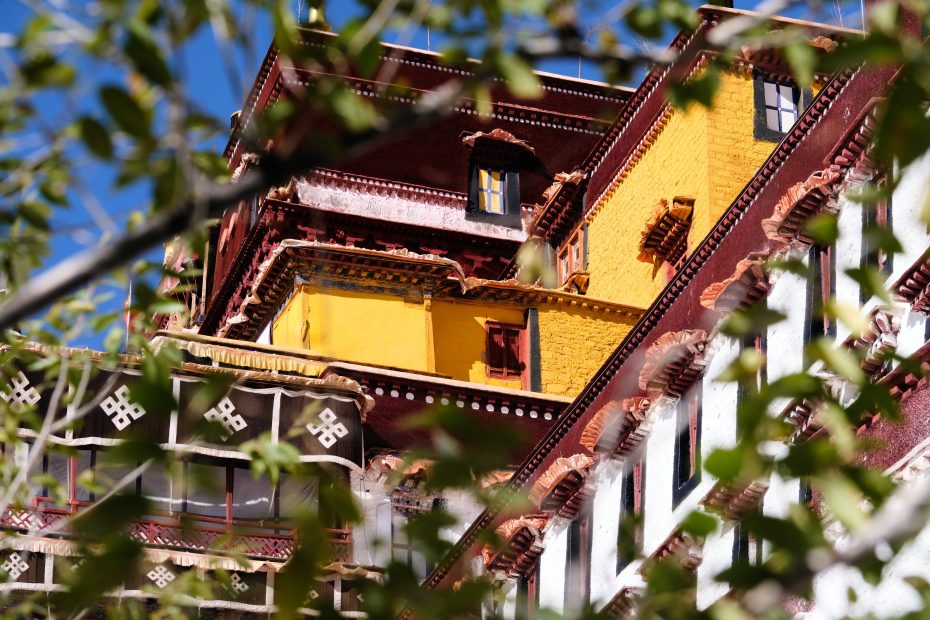Table of Contents
Introduction
Rising from the center of Lhasa like a sacred mountain is the awe-inspiring Potala Palace. This massive structure is both a historic landmark and a living shrine, representing the heart and soul of Tibet. For centuries, the Potala Palace served as the spiritual and political center of Tibet, housing generations of Dalai Lamas and their government. With over 1,000 rooms filled with statues, shrines and precious artifacts, it stands as a monument to Tibetan Buddhism today. For Tibetans and Buddhists worldwide, a visit to the storied Potala Palace provides an encounter with profound spirituality.
Architecture and Layout
The Potala Palace crowns Marpo Ri hill, rising over 300 feet and dominating the Lhasa Valley. This strategically chose site features holy caves and was the location of King Songtsen Gampo’s 7th century temple. Construction began in 1645 under the Fifth Dalai Lama and expanded through the centuries into the labyrinthine structure seen today. Over 1,000 rooms are contained within the Potala’s massive walls, along with countless shrines, chapels and chanting halls. The layout follows both defensive strategies and principles of Tibetan Buddhism, with privileged groups living higher up the mountain.
Spiritual History
Spiritual meaning permeates every stone and timber of the Potala Palace. It was built on the site of an original 7th century temple constructed by King Songtsen Gampo. This king is credited with uniting Tibet and introducing Buddhism. Later, Songtsen Gampo, his Chinese princess wife and future Dalai Lamas were believed to be incarnations of Avalokiteshvara, the Buddha of compassion. When the Fifth Dalai Lama started work on the Potala Palace, it was intended as a sacred monument expressing the divine power of the Dalai Lamas. For over 300 years until the 1950s, each Dalai Lama dwelled at this holy site.
Interior Spaces and Contents
Within the Potala’s walls are countless chapels containing sacred objects, along with shrines, tombs and frescoes. Many chapels hold the tombs of past Dalai Lamas, who are mummified and richly dressed. Statues fill the interior, including a 26-foot gilded statue of Avalokiteshvara. Thangka tapestries depicting Buddhist imagery adorn the walls. There are also myriad manuscripts, musical instruments and ritual items used by the monks and Dalai Lamas over the centuries. All of these precious contents make the Potala an invaluable repository of Tibetan spiritual culture.
Daily Spiritual Life
While they lived at the Potala, the Dalai Lamas and the thousands of monks had a rigorous daily routine focused on spiritual practices. At dawn, monks gathered for prayers and chanting. Scriptures would be read, prayers recited, and butter lamps lit in shrines. The Dalai Lama would give discourses to the monks and appointments to pilgrims who travelled from across Tibet. Ceremonies, initiations and blessings took place on a frequent basis. Every aspect of life revolved around Tibetan Buddhist rituals and teachings within the Potala’s sacred spaces.
Pilgrimage Site
For Tibetan Buddhists, a pilgrimage to the Potala is an important life goal. The chief object of veneration is the stupa tomb containing Songtsen Gampo’s remains which was moved here from his original temple. Pilgrims perform a kora – a circumambulation around the sacred Marpo Ri hill. It is also highly auspicious to catch a glimpse of or receive a blessing from the Dalai Lama. Although the current Dalai Lama no longer resides here, this sacred site still powerfully embodies his enduring spiritual legacy.
Symbol of Tibet
With its grandiose white and maroon walls rising above Lhasa, the Potala has become an enduring symbol of Tibet. It represented the power of the Dalai Lamas and the Tibetan state for centuries. Since the Chinese takeover of Tibet, it stands as a reminder of past cultural sovereignty. While controlled by Chinese authorities, it remains a powerful emblem of Tibetan identity. This complex role as spiritual sanctuary, historic monument and national symbol continues to inspire passion and debate.
Restoration and Preservation
Due to age, warfare and earthquakes, the Potala Palace had fallen into disrepair by the late 1900s. Starting in 1989 an immense restoration project began aiming to repair and fortify the structure. Craftspeople used traditional building techniques to restore the roof, walls, and many chapels. One major debate was how to protect the site while also preserving its authentic historic feel. Despite modernizations, the Potala retains its original essence – an awe-inspiring sacred mountain towering over Lhasa.
Conclusion
The Potala Palace is an architectural wonder and spiritual sanctum, encapsulating Tibetan culture and Buddhism. Its history spans the introduction of Buddhism to Tibet, through centuries of devout monastic life, into the modern era where it remains a stirring symbol. While no longer home to the Dalai Lama, it stands as a moving testament to Tibetan spirituality, history and identity, welcoming reverent pilgrims and travelers from afar. This sacred palace on a hill has become Lhasa’s most iconic treasure, and one of the world’s most precious Buddhist sites.
FAQs
When was the Potala Palace built?
The Potala Palace was built starting in 1645 under the Fifth Dalai Lama, on the site of a 7th century temple. It expanded over the centuries until the 1950s.
How many rooms are in the Potala Palace?
The Potala Palace contains over 1,000 rooms, including shrines, tombs, chapels, chanting halls, libraries, living quarters and government offices.
Why is the Potala Palace sacred to Tibetan Buddhists?
It is built on an ancient holy site and contains many sacred shrines and relics. The Dalai Lamas lived there and are revered as holy incarnations, so their residence is holy.
What religious rituals and events took place in the Potala Palace?
Monks performed daily prayers and rituals. The Dalai Lama gave discourses and initiations, granted audiences and blessings. Relics were displayed on holy days.
Why did the Dalai Lamas live in the Potala Palace?
It was considered a sacred site associated with Tibet’s conversion to Buddhism. Located high on a mountain, it had defensive advantages. It also displayed the power and divinity of the Dalai Lamas.
